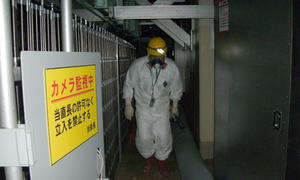DisastersMore setbacks at Japan's beleaguered nuclear plant
Japan’s latest efforts to contain reactor no. 1 at the Fukushima Daiichi plant hit a major obstacle last Saturday when a worker discovered a large pool of radioactive water in the reactor building; the pool is an estimated 18 feet deep and holds as much as 3,000 tons of water, more volume than an Olympic sized swimming pool; additional measures were being readied to treat and store radioactive water at Fukushima; officials have begun preparing a nearly 450 foot long “Mega-Float” that was previously used as an artificial island for fishing south of Tokyo to store the contaminated water

Inside the Fukushima Daiichi No.1 reactor building // Source: infiniteunknown.net
Japan’s latest efforts to contain reactor no. 1 at the Fukushima Daiichi plant hit a major obstacle last Saturday when a worker discovered a large pool of radioactive water in the reactor building.
The pool is an estimated 18 feet deep and holds as much as 3,000 tons of water, more volume than an Olympic sized swimming pool.
The power plant’s operator, Tokyo Electric Power (TEPCO) had originally planned to begin a “cold shutdown” by flooding the reactor core with cold water to bring down the temperature and prevent it from boiling the water around it. But this latest development has made this approach increasingly difficult as the water must first be pumped out and safely stored.
According to Hidehiko Nishiyama, a spokesman for Japan’s Nuclear and Industrial Safety Agency, additional measures were being readied to treat and store the radioactive water from Fukushima.
Officials have begun preparing a nearly 450 foot long “Mega-Float” that was previously used as an artificial island for fishing to store the contaminated water.
The water is likely the result of small holes in the containment unit created by the partially melted nuclear fuel.
Last week the plant’s operators revealed that hours after the 11 March earthquake and tsunami had wiped out the plant’s cooling systems, the fuel rods at reactor no. 1 had melted down and were resting at the bottom of its containment unit.
Confounding cleanup efforts were continued high levels of radiation that have made it difficult for workers to approach the reactor buildings or work there for any substantive period of time.
On Friday, a robot equipped with radiation sensors sent into the first floor of reactor no. 1 detected radiation levels of 2,000 millisieverts per hour. At such levels, workers can only stay in the area for eight minutes before reaching exposure limits.
Despite these many obstacles, officials at TEPCO remain optimistic that they can achieve their goal of gaining control over the reactors by the end of the year.
Goshi Hosono, an adviser to Prime Minister Naoto Kan, said, “We want to preserve the timetable, but at the same time we’re going to have to change our approach,”
He added that the government would announce its timetable for bringing the crisis under control on Tuesday, after TEPCO provides an updated timetable as well.
Analysts estimate that the nuclear crisis will cost Japan somewhere between $50 billion and $100 billion in addition to the costs of rebuilding coastal communities that were flattened by the tsunami. Some economists project that the costs of rebuilding alone would be $200 billion.
TEPCO is currently preparing a plan to compensate thousands of local residents, farmers, fishermen, and businesses who have been affected by the nuclear disaster. The payment plan would be overseen and partially funded by the government.
